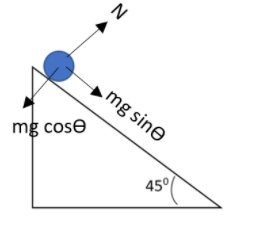
A disc has a radius $20cm$ and a mass half kg found to be rolling on an inclined plane. What will be the force of friction so that the disc will perform pure rolling?

$\begin{align}
& A.\dfrac{5\sqrt{2}}{3}N \\
& B.\dfrac{5}{3\sqrt{2}}N \\
& C.\dfrac{5}{\sqrt{2}}N \\
& D.\dfrac{5}{2\sqrt{3}}N \\
\end{align}$

Answer
463.2k+ views
Hint: From the diagram, derive the equation of the balancing of the force. The torque of the centre of mass can be found to be equivalent to the product of the moment of inertia of the centre of mass and the angular acceleration of the body. Rearrange the equation in terms of friction. Substitute the torque in this and substitute the values. This will help you in answering this question.
Complete step by step answer:

It has been mentioned that the radius of the disk has been given as,
$r=20cm$
Mass of the body has been mentioned as,
$m=\dfrac{1}{2}Kg$
According to the diagram mentioned, we can write that,
$mg\sin \theta -f=m{{a}_{cm}}$…….. (1)
Where $f$be the force of friction.
The torque of the centre of mass can be found to be equivalent to the product of the moment of inertia of the centre of mass and the angular acceleration of the body. That is we can write that,
${{\tau }_{cm}}={{I}_{cm}}\cdot \alpha $
And also we can write that,
\[{{f}_{R}}=\dfrac{M{{R}^{2}}}{2}\times \left( \dfrac{{{a}_{cm}}}{{{R}^{2}}} \right)\]
Simplifying this equation can be written as,
\[{{f}_{R}}=\dfrac{M}{2}\times {{a}_{cm}}\]
Rearranging this equation can be written as,
\[{{a}_{cm}}=\dfrac{2f}{M}\]
Substituting this in equation (1) can be shown as,
\[mg\sin \theta -f=M\left( \dfrac{2f}{M} \right)\]
From this the force of friction can be found to be as,
\[f=\dfrac{mg\sin \theta }{3}\]
The angle of inclination has been mentioned as,
\[\theta =45{}^\circ \]
Substituting all these values in it will give,
\[f=\dfrac{1\times 10\times 1}{2\times 3\times \sqrt{2}}=\dfrac{5}{3\sqrt{2}}N\]
Hence the force of friction has been found to be,
\[f=\dfrac{5}{3\sqrt{2}}N\]
So, the correct answer is “Option B”.
Note: Centre of mass is the imaginary point of a body or a particle which is considered to be the point where the whole mass of the body is found to be concentrated. All the properties of the body will be shown by this particle. Frictional force is the opposition provided due to the surface body interactions.
Complete step by step answer:

It has been mentioned that the radius of the disk has been given as,
$r=20cm$
Mass of the body has been mentioned as,
$m=\dfrac{1}{2}Kg$
According to the diagram mentioned, we can write that,
$mg\sin \theta -f=m{{a}_{cm}}$…….. (1)
Where $f$be the force of friction.
The torque of the centre of mass can be found to be equivalent to the product of the moment of inertia of the centre of mass and the angular acceleration of the body. That is we can write that,
${{\tau }_{cm}}={{I}_{cm}}\cdot \alpha $
And also we can write that,
\[{{f}_{R}}=\dfrac{M{{R}^{2}}}{2}\times \left( \dfrac{{{a}_{cm}}}{{{R}^{2}}} \right)\]
Simplifying this equation can be written as,
\[{{f}_{R}}=\dfrac{M}{2}\times {{a}_{cm}}\]
Rearranging this equation can be written as,
\[{{a}_{cm}}=\dfrac{2f}{M}\]
Substituting this in equation (1) can be shown as,
\[mg\sin \theta -f=M\left( \dfrac{2f}{M} \right)\]
From this the force of friction can be found to be as,
\[f=\dfrac{mg\sin \theta }{3}\]
The angle of inclination has been mentioned as,
\[\theta =45{}^\circ \]
Substituting all these values in it will give,
\[f=\dfrac{1\times 10\times 1}{2\times 3\times \sqrt{2}}=\dfrac{5}{3\sqrt{2}}N\]
Hence the force of friction has been found to be,
\[f=\dfrac{5}{3\sqrt{2}}N\]
So, the correct answer is “Option B”.
Note: Centre of mass is the imaginary point of a body or a particle which is considered to be the point where the whole mass of the body is found to be concentrated. All the properties of the body will be shown by this particle. Frictional force is the opposition provided due to the surface body interactions.
Recently Updated Pages
Master Class 11 Accountancy: Engaging Questions & Answers for Success

Glucose when reduced with HI and red Phosphorus gives class 11 chemistry CBSE

The highest possible oxidation states of Uranium and class 11 chemistry CBSE

Find the value of x if the mode of the following data class 11 maths CBSE

Which of the following can be used in the Friedel Crafts class 11 chemistry CBSE

A sphere of mass 40 kg is attracted by a second sphere class 11 physics CBSE

Trending doubts
10 examples of friction in our daily life

Difference Between Prokaryotic Cells and Eukaryotic Cells

One Metric ton is equal to kg A 10000 B 1000 C 100 class 11 physics CBSE

State and prove Bernoullis theorem class 11 physics CBSE

What organs are located on the left side of your body class 11 biology CBSE

Define least count of vernier callipers How do you class 11 physics CBSE




